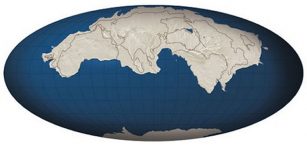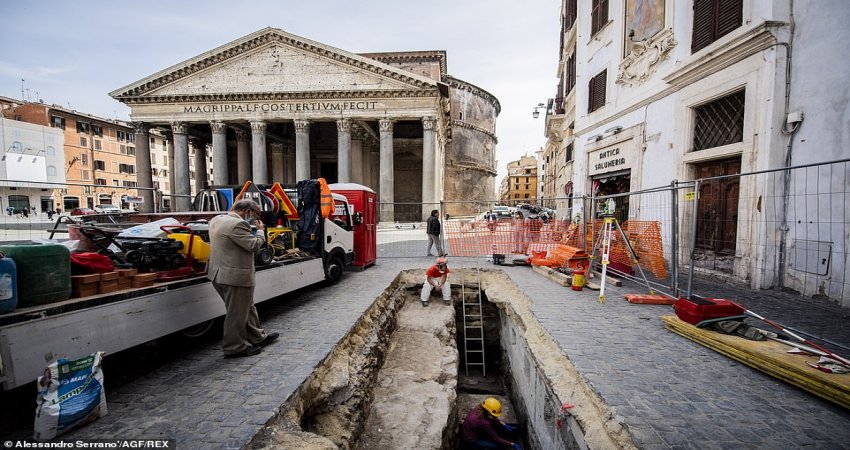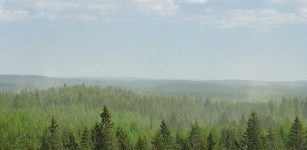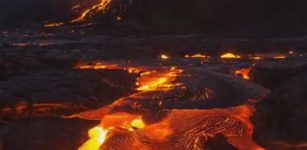Pieces Of Ancient Ocean Floor, Earth’s Inner Mantle Identified In Baltimore-Area Rocks
Eddie Gonzales Jr. – MessageToEagle.com – Separately and to the untrained eye, they are not particularly distinguished rocks — the backdrop to several holes at the Forest Park Golf Course, part of an excavation to improve the water system at Lake Ashburton, or left behind in abandoned quarries and mines around the area.
But new research has concluded they are part of a geological upheaval hundreds of millions of years ago, when the collision of the Earth’s tectonic plates thrust fragments of the floor and rocks of a now-vanished ocean up through the surface, where they remain to this day.
Seen from above, Soldiers Delight Natural Environmental Area in Owings Mills has large areas where plant growth is stunted. These ecosystems sit on top of serpentinite, an oceanic rock high in magnesium with few essential nutrients for plant growth. (Jerry Jackson/Baltimore Sun/TNS)
It is not every day that the Baltimore area, not normally as geologically wondrous as a Grand Canyon or a Norwegian fjord, figures into such a finding.
“We can’t see a huge amount of the geology because there’s a big ol’ city built on top of it,” said George Guice, the lead researcher and a geologist at the National Museum of Natural History in Washington. “These windows into the Earth’s crust are relatively rare.”
Guice and a team that includes Johns Hopkins University geologists published their research in February in Geosphere, a journal of the Geological Society of America, and it drew a wider audience last week when National Geographic posted an article online about it.
Geologists have long theorized that outcroppings in the area contain ophiolite fragments – parts of oceanic crust and the underlying layer of rocks known as the mantle that have been propelled onto land. But the researchers say this is the first time chemical analysis has provided evidence for that in this area.
Beneath the science of all this is a mind-boggling geological story. It’s one in which continental masses collide into one another and break apart and oceans form and disappear, a world in continual, if exceedingly slow, flux and in which at one point, the Appalachians of the eastern United States were part of the same range as mountains in Scotland and Morocco.
Guice’s research stems from his move two years ago to Washington, where he is a postdoctoral fellow at the Smithsonian’s natural history museum. A native of the Birmingham, England, area – “Peaky Blinders” territory, as he describes it, referring to the period British crime drama on Netflix – he scoped out the local rock situation, what was known about it, who had or was researching it.
That and professional connections led him to take the train to Baltimore on “a swelteringly hot day” in August 2019 to meet geologists from Hopkins. At Penn Station, he realized he didn’t know who to look for, but then saw “a minibus full of various geologist-looking people.” (Apparently one giveaway: clothing with lots of pockets for pens and tools and such.)
“We scooped him up and went straight to the field,” said Daniel Viete, an assistant professor in Hopkins’ earth and planetary sciences department.
On “a whirlwind tour” of Baltimore rock formations, followed, of course, by an Orioles game at Camden Yards, the seeds of a research project started to take root.
The group went on to take samples of rocks that are part of the Baltimore Mafic Complex, a band of intermittent outcroppings that extends from the metropolitan area northeast to the Pennsylvania line and was involved in the formation of the Appalachian Mountains. The samples came from five sites, including the Hollofield Quarry in the Patapsco Valley State Park and Soldiers Delight Natural Environment Area in Owings Mills, and were then analyzed for chemical signs that would indicate their origins.
The research brought the deep, deep past into present-day life in these areas, such as at Lake Ashburton, where an ongoing project to build underground water tanks provided a pile of rocks for the geologists to rummage through, to the Forest Park golf course, where the rocks are such a part of the landscape that they are included in its logo.
“Neat,” responded Ed Miller, the course’s golf pro, when he learned of the findings. The outcroppings draw even nongolfers to the municipal course – they like to picnic on them – and are akin to a sand trap or water hazard for those who do play, he said.
“Not infrequently,” Miller said, “they’ll get the crooked shots.”
At Soldiers Delight, the new study aligns with what “we’ve basically understood” about its unusual rock formations, said Laura Van Scoyoc, who heads the area’s group of volunteers, “that they were originally oceanic crust that got smushed up onto the land.”
Exposed mantle rock is seen along a power line access road in Soldiers Delight. (Jerry Jackson/Baltimore Sun/TNS)
She and others say that while they welcome the new scholarship, they fear it may draw amateurs who decide to chisel out a souvenir piece of the Earth’s mantle.
That’s neither cool nor legal at state-controlled areas like Soldiers Delight, where visitors should stay on trails to avoid trampling rare species, or the Patapsco park.
“Public lands are completely off limits to help protect our shared natural resources,” the state Department of Natural Resources says on a webpage for amateur mineral hunters.
For Hopkins’ Viete, the research took him full circle. When he moved to Baltimore five years ago, he quickly noticed similarities in some of the building materials to Scotland, where he previously had done research.
“They have the same rocks,” he said.
The ocean that produced the Baltimore ophiolite fragments is the long-gone Iapetus, named for the mythical father of Atlas. Around 460 million years ago, the Iapetus began closing as various continental masses converged and collided, and masses of rocks piled up to eventually form the Appalachians.
The Baltimore area is part of a belt running from Alabama north to Newfoundland that was part of this formation.
Less is known about the central and southern portion than the northern end, geologists say. That’s in part because in a place like Newfoundland, the rocks are much more exposed.
Another contributing factor may simply be that it is a big world, billions of years in the making.
“There’s a long list of outstanding questions in geology, more than the number of geologists,” said William Junkin, a geologist with Maryland Geological Survey.
Junkin said state geologists have long cataloged and studied these rocks, and in the past developed good evidence working with available data at the time supporting theories of their origins. And indeed, the new research cites work from the 1970s of a state geologist, the late William Patrick Crowley.
“We’re just thrilled to get new evidence that supports our past work,” Junkin said.
Viete said he has secured funding for related research on the subject, in Baltimore and beyond, that he hopes will have the added benefit of expanding the view of his field – that it’s not just something found in the exotic, remote outposts of the planet where the geology is on glamorous display.
“The cool thing about Baltimore is it’s very different from the others,” Viete said. “People don’t associate geology with an urban area. But the rocks here in Baltimore are just as cool.”
Source: The Baltimore Sun
Written by Eddie Gonzales Jr. – MessageToEagle.com Staff












